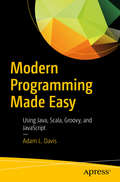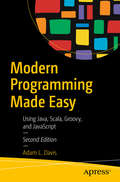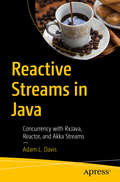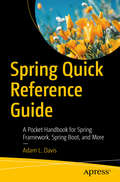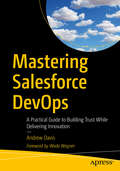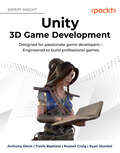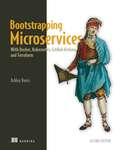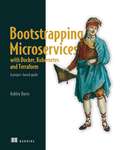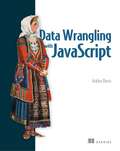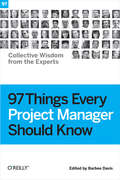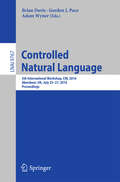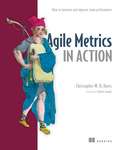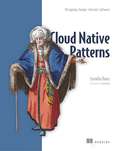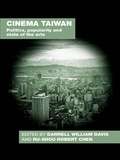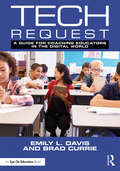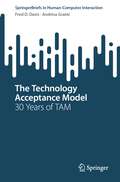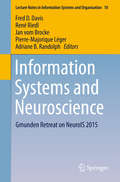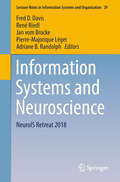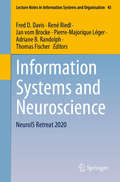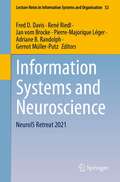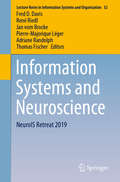- Table View
- List View
Modern Programming Made Easy
by Adam L. DavisGet up and running fast with the basics of programming using Java as an example language. This short book gets you thinking like a programmer in an easy and entertaining way. Modern Programming Made Easy teaches you basic coding principles, including working with lists, sets, arrays, and maps; coding in the object-oriented style; and writing a web application. This book is language agnostic, but will mainly cover Java, with some references to Groovy, Scala, and JavaScript to give you a broad range of examples to consider. You will get a taste of what modern programming has to offer and set yourself up for further study and growth in your chosen language. What You'll Learn Code using the functional programming style Build and test your code Read and write from files Design user interfaces Deploy your app in the cloud Who This Book Is For Anyone who wants to learn how to code. Whether you're a student, a teacher, looking for a career change, or just a hobbyist, this book is made for you.
Modern Programming Made Easy: Using Java, Scala, Groovy, and JavaScript
by Adam L. DavisGet up and running fast with the basics of programming using Java as an example language. This short book gets you thinking like a programmer in an easy and entertaining way. Modern Programming Made Easy teaches you basic coding principles, including working with lists, sets, arrays, and maps; coding in the object-oriented style; and writing a web application. This book is largely language agnostic, but mainly covers the latest appropriate and relevant release of Java, with some updated references to Groovy, Scala, and JavaScript to give you a broad range of examples to consider. You will get a taste of what modern programming has to offer and set yourself up for further study and growth in your chosen language. What You'll Learn Write code using the functional programming style Build your code using the latest releases of Java, Groovy, and more Test your code Read and write from files Design user interfaces Deploy your app in the cloud Who This Book Is For Anyone who wants to learn how to code. Whether you're a student, a teacher, looking for a career change, or just a hobbyist, this book is made for you.
Reactive Streams in Java: Concurrency with RxJava, Reactor, and Akka Streams
by Adam L. DavisGet an easy introduction to reactive streams in Java to handle concurrency, data streams, and the propagation of change in today's applications. This compact book includes in-depth introductions to RxJava, Akka Streams, and Reactor, and integrates the latest related features from Java 9 and 11, as well as reactive streams programming with the Android SDK. Reactive Streams in Java explains how to manage the exchange of stream data across an asynchronous boundary—passing elements on to another thread or thread-pool—while ensuring that the receiving side is not forced to buffer arbitrary amounts of data which can reduce application efficiency. After reading and using this book, you'll be proficient in programming reactive streams for Java in order to optimize application performance, and improve memory management and data exchanges. What You Will LearnDiscover reactive streams and how to use themWork with the latest features in Java 9 and Java 11Apply reactive streams using RxJava Program using Akka StreamsCarry out reactive streams programming in Android Who This Book Is For Experienced Java programmers.
Spring Quick Reference Guide: A Pocket Handbook for Spring Framework, Spring Boot, and More
by Adam L. DavisQuickly gain the insight necessary to address a multitude of Java-based Spring Framework and Spring Boot coding challenges using this succinct reference guide. Short, focused code examples will help you master many of the Spring elements such as AOP, data access, MVC for web development, security, web services/REST for microservices development, Batch for large data sets, and more. You’ll also get a rundown of the increasingly popular Spring Boot microframework as well.You won’t find any technical jargon, bloated samples, drawn out history lessons, or witty stories in this book. What you will find is a language reference that is concise, to the point, and highly accessible. The book is packed with useful information and is a must-have for any Java programmer.What You Will LearnDiscover the Spring Framework and its many sub-projectsWork with the Spring Boot microframeworkProgram with the Spring Boot framework to build Java-basedmicroservices, native cloud applications, and moreUse some of the lesser-known but still important frameworks and tools such as REST Docs, HATEOAS, Cloud, and moreLeverage these Spring frameworks and tools for building your next Java-based cloud applicationWho This Book Is ForThose with prior experience with Java who want a quick and handy reference to using Spring.
Mastering Salesforce DevOps: A Practical Guide to Building Trust While Delivering Innovation
by Andrew DavisThis practical guide brings DevOps principles to Salesforce development. It fits together two major movements within the IT world: the movement to Software/Platform as a Service (SaaS/PaaS), and the DevOps movement. While SaaS and PaaS allow companies to invest in their core competencies rather than maintain their own infrastructure, the goal of DevOps is to optimize the process of delivering software innovation and value. The release of Salesforce DX in late 2017 unlocks the possibility of a true DevOps workflow on Salesforce. But DevOps is new to the Salesforce world and there is not a widespread understanding of its goals and methods, and so adoption of Salesforce DX is still in the early stages. Mastering Salesforce DevOps explains how to build a powerful and comprehensive DevOps workflow for Salesforce—allowing you to finally deploy the world's most innovative platform using the world's most effective and efficient techniques. It addresses the need for a comprehensive guide to DevOps for Salesforce, allowing teams to bring proven practices from the IT world to resolve the hardest problems facing Salesforce developers today. What You Will LearnImprove company performance and software delivery performance using Salesforce DXTranslate DevOps concepts into the unique language and practices of SalesforceUnderstand why and how you can implement Salesforce DX to achieve greater productivity and innovationEnable continuous delivery on SalesforceBuild packages and architect code so it can be deployed easilyAllow admins to participate in what has traditionally been a developer workflowKnow the techniques for reducing the stress and risk of deploymentApply the full range of automated tests that can be used on Salesforce Who This Book Is for Salesforce developers, release managers, and those managing Salesforce development teams who need a guide to DevOps, and DevOps specialists who need to apply familiar concepts to Salesforce
Unity 3D Game Development: Designed for passionate game developers Engineered to build professional games
by Anthony Davis Travis Baptiste Russell Craig Ryan StunkelCreate ready-to-play 3D games with reactive environments, sound, dynamic effects, and more!Key FeaturesBuild a solid foundation for game design and game developmentUnderstand the fundamentals of 3D such as coordinates, spaces, vectors, and camerasGet to grips with essential Unity concepts including characters, scenes, terrains, objects and moreBook DescriptionThis book, written by a team of experts at Unity Technologies, follows an informal, demystifying approach to the world of game development.You'll learn the 3D and C# fundamentals before starting to build one short segment of the full game — a vertical slice. With every progressing chapter, you'll learn to improve this game (alongside building your own) to make it ready to pitch to studios.Within Unity 3D Game Development, you will learn to:Design and build 3D characters, and the game environmentThink about the users' interactions with your gameDevelop the interface and apply visual effects to add an emotional connection to your worldGrasp a solid foundation of sound design, animations, and lightning to your creationsBuild, test, and add final touchesThe book is split between expert insights that you'll read before you look into the project on GitHub to understand all the underpinnings. This way, you get to see the end result, and you're allowed to be creative and give your own thoughts to design, as well as work through the process with the new tools we introduce.Join the book community on Discord: Read this book with Unity game developers, and the team of authors. Ask questions, build teams, chat with the authors, participate in events and much more. The link to join is included in the book.What you will learnLearn fundamentals of designing a 3D game and C# scriptingDesign your game character and work through their mechanics and movementsCreate an environment with Unity Terrain and ProBuilderExplore instantiation and rigid bodies through physics theory and codeImplement sound, lighting effects, trail rendering, and other dynamic effectsCreate a short, fully functional segment of your game in a vertical slicePolish your game with performance tweaksJOIN the book-club' to read alongside other users, Unity experts, and ask the authors when stuckWho this book is forOur goal with this book is to enable every reader to build the right mindset to think about 3D games, and then show them all the steps we took to create ours.The main target audience for this book is those with some prior knowledge in game development, though regardless of your experience, we hope to create an enjoyable learning journey for you.
Bootstrapping Microservices, Second Edition: With Docker, Kubernetes, GitHub Actions, and Terraform
by Ashley DavisBuild a microservices application from scratch using industry standard tools and battle-tested best practices.The best way to learn microservices development is to build something! Bootstrapping Microservices with Docker, Kubernetes, GitHub Actions, and Terraform, Second Edition guides you from zero through to a complete microservices project, including fast prototyping, development, and deployment. In Bootstrapping Microservices, Second Edition you&’ll get hands-on experience with microservices development skills like: Creating, configuring, and running a microservice with Node.js Building and publishing a microservice using Docker Applying automated testing Running a microservices application in development with Docker Compose Deploying microservices to a production Kubernetes cluster Implementing infrastructure as code and setting up a continuous delivery pipeline Monitoring, managing, and troubleshooting Bootstrapping Microservices with Docker, Kubernetes, GitHub Action, and Terraform has helped thousands of developers create their first microservices applications. This fully revised second edition introduces the industry-standard tools and practical skills you&’ll use for every microservices application. Author Ashley Davis&’s friendly advice and guidance helps cut down the learning curve for Docker, Terraform, and Kubernetes, showing you just what you need to know to start building. About the technology Taking a microservices application from proof of concept to production requires many steps and a host of tools like Kubernetes, Terraform, and GitHub Actions. But where do you start? With clear, practical introductions to each concept and tool, this book guides you hands-on through designing and building your first microservices application. About the book Bootstrapping Microservices, Second Edition is your microservices mentor. It teaches you to use industry-standard tools to create a working video streaming application from the ground up. You&’ll learn the pillars of cloud-native development, including Terraform for configuration, Docker for packaging, and a basic Kubernetes deployment. Plus, this second edition includes coverage of GitHub Actions, continuous delivery, and Infrastructure as Code. What's inside Deploying microservices to Kubernetes Automated testing and continuous delivery Monitoring, managing, and troubleshooting About the reader Examples are in JavaScript and Node. No experience with microservices required. About the author Ashley Davis is a software craftsman, entrepreneur, and author with over 25 years of experience in software development—from coding, to managing teams, to founding companies. Table of Contents 1 Why microservices? 2 Creating your first microservice 3 Publishing your first microservice 4 Data management for microservices 5 Communication between microservices 6 The road to production 7 Infrastructure as code 8 Continuous deployment 9 Automated testing for microservices 10 Shipping FlixTube 11 Healthy microservices 12 Pathways to scalability
Bootstrapping Microservices with Docker, Kubernetes, and Terraform: A project-based guide
by Ashley DavisSummary The best way to learn microservices development is to build something! Bootstrapping Microservices with Docker, Kubernetes, and Terraform guides you from zero through to a complete microservices project, including fast prototyping, development, and deployment. You&’ll get your feet wet using industry-standard tools as you learn and practice the practical skills you&’ll use for every microservices application. Following a true bootstrapping approach, you&’ll begin with a simple, familiar application and build up your knowledge and skills as you create and deploy a real microservices project. Purchase of the print book includes a free eBook in PDF, Kindle, and ePub formats from Manning Publications. About the technology Taking microservices from proof of concept to production is a complex, multi-step operation relying on tools like Docker, Terraform, and Kubernetes for packaging and deployment. The best way to learn the process is to build a project from the ground up, and that&’s exactly what you&’ll do with this book! About the book In Bootstrapping Microservices with Docker, Kubernetes, and Terraform, author Ashley Davis lays out a comprehensive approach to building microservices. You&’ll start with a simple design and work layer-by-layer until you&’ve created your own video streaming application. As you go, you&’ll learn to configure cloud infrastructure with Terraform, package microservices using Docker, and deploy your finished project to a Kubernetes cluster. What's inside Developing and testing microservices applications Working with cloud providers Applying automated testing Implementing infrastructure as code and setting up a continuous delivery pipeline Monitoring, managing, and troubleshooting About the reader Examples are in JavaScript. No experience with microservices, Kubernetes, Terraform, or Docker required. About the author Ashley Davis is a software developer, entrepreneur, stock trader, and the author of Manning&’s Data Wrangling with JavaScript. Table of Contents 1 Why microservices? 2 Creating your first microservice 3 Publishing your first microservice 4 Data management for microservices 5 Communication between microservices 6 Creating your production environment 7 Getting to continuous delivery 8 Automated testing for microservices 9 Exploring FlixTube 10 Healthy microservices 11 Pathways to scalability
Data Wrangling with JavaScript
by Ashley DavisSummaryData Wrangling with JavaScript is hands-on guide that will teach you how to create a JavaScript-based data processing pipeline, handle common and exotic data, and master practical troubleshooting strategies.Purchase of the print book includes a free eBook in PDF, Kindle, and ePub formats from Manning Publications.About the TechnologyWhy not handle your data analysis in JavaScript? Modern libraries and data handling techniques mean you can collect, clean, process, store, visualize, and present web application data while enjoying the efficiency of a single-language pipeline and data-centric web applications that stay in JavaScript end to end.About the BookData Wrangling with JavaScript promotes JavaScript to the center of the data analysis stage! With this hands-on guide, you'll create a JavaScript-based data processing pipeline, handle common and exotic data, and master practical troubleshooting strategies. You'll also build interactive visualizations and deploy your apps to production. Each valuable chapter provides a new component for your reusable data wrangling toolkit.What's insideEstablishing a data pipelineAcquisition, storage, and retrievalHandling unusual data setsCleaning and preparing raw dataInteractive visualizations with D3About the ReaderWritten for intermediate JavaScript developers. No data analysis experience required.About the AuthorAshley Davis is a software developer, entrepreneur, author, and the creator of Data-Forge and Data-Forge Notebook, software for data transformation, analysis, and visualization in JavaScript.Table of ContentsGetting started: establishing your data pipelineGetting started with Node.jsAcquisition, storage, and retrievalWorking with unusual dataExploratory codingClean and prepareDealing with huge data filesWorking with a mountain of dataPractical data analysisBrowser-based visualizationServer-side visualizationLive dataAdvanced visualization with D3Getting to production
97 Things Every Project Manager Should Know: Collective Wisdom from the Experts
by Barbee DavisIf the projects you manage don't go as smoothly as you'd like, 97 Things Every Project Manager Should Know offers knowledge that's priceless, gained through years of trial and error. This illuminating book contains 97 short and extremely practical tips -- whether you're dealing with software or non-IT projects -- from some of the world's most experienced project managers and software developers. You'll learn how these professionals have dealt with everything from managing teams to handling project stakeholders to runaway meetings and more. While this book highlights software projects, its wise axioms contain project management principles applicable to projects of all types in any industry. You can read the book end to end or browse to find topics that are of particular relevance to you. 97 Things Every Project Manager Should Know is both a useful reference and a source of inspiration. Among the 97 practical tips:"Clever Code Is Hard to Maintain...and Maintenance Is Everything" -- David Wood, Partner, Zepheira "Every Project Manager Is a Contract Administrator" -- Fabio Teixeira de Melo, Planning Manager, Construtora Norberto Odebrecht "Can Earned Value and Velocity Coexist on Reports?" -- Barbee Davis, President, Davis Consulting "How Do You Define 'Finished'"? -- Brian Sam-Bodden, author, software architect "The Best People to Create the Estimates Are the Ones Who Do the Work" -- Joe Zenevitch, Senior Project Manager, ThoughtWorks "How to Spot a Good IT Developer" -- James Graham, independent management consultant "One Deliverable, One Person" -- Alan Greenblatt, CEO, Sciova
We're Engaged!
by Bob Davis Dawn DavisToday's brides- and grooms-to-be have grown up inundated by world-class photography on the Internet, television, magazines, and social networking sites. Therefore, it's no surprise that these savvy, image-conscious consumers have high expectations when commissioning their engagement portraits. They want unique, innovative images that make them look great and reflect their personal style as individuals and as a couple. In this book, acclaimed photographers Bob and Dawn Davis show you how to rise to that lofty goal and deliver memorable, personalized images from each session. Covering the process from start to finish, you'll learn how to select locations, work with clients on their styling, get great poses even from camera-shy subjects, and find (or create) amazing lighting indoors and out-all day long. Lighting diagrams paired with each final image selection, along with supporting image variations from the same session, make it easy to learn!
Controlled Natural Language: 5th International Workshop, CNL 2016, Aberdeen, UK, July 25-27, 2016, Proceedings (Lecture Notes in Computer Science #9767)
by Brian Davis Gordon J. Pace Adam WynerThis book constitutes the refereed proceedings of the 5th International Workshop on Controlled Natural Language, CNL 2016, held in Aberdeen, UK, in July 2016. The 11 full papers presented were carefully reviewed and selected from 15 submissions. The topics range from natural languages which are controlled, to controlled languages with a natural language flavour; and from more theoretical results to interfaces, reasoning engines and real-life applications of CNLs.
Agile Metrics in Action: How to measure and improve team performance
by Christopher DavisSummaryAgile Metrics in Action is a rich resource for agile teams that aim to use metrics to objectively measure performance. You'll learn how to gather data that really counts, along with how to effectively analyze and act upon the results.Purchase of the print book includes a free eBook in PDF, Kindle, and ePub formats from Manning Publications.About the BookThe iterative nature of agile development is perfect for experience-based, continuous improvement. Tracking systems, test and build tools, source control, continuous integration, and other built-in parts of a project lifecycle throw off a wealth of data you can use to improve your products, processes, and teams. The question is, how to do it?Agile Metrics in Action teaches you how. This practical book is a rich resource for an agile team that aims to use metrics to objectively measure performance. You'll learn how to gather the data that really count, along with how to effectively analyze and act upon the results. Along the way, you'll discover techniques all team members can use for better individual accountability and team performance.Practices in this book will work with any development process or tool stack. For code-based examples, this book uses Groovy, Grails, and MongoDB.What's InsideUse the data you generate every day from CI and ScrumImprove communication, productivity, transparency, and moraleObjectively measure performanceMake metrics a natural byproduct of your development processAbout the AuthorChristopher Davis has been a software engineer and team leader for over 15 years. He has led numerous teams to successful delivery using agile methodologies.Table of ContentsPART 1 MEASURING AGILE TEAMSMeasuring agile performanceObserving a live projectPART 2 COLLECTING AND ANALYZING YOUR TEAM'S DATATrends and data from project-tracking systemsTrends and data from source controlTrends and data from CI and deployment serversData from your production systemsPART 3 APPLYING METRICS TO YOUR TEAMS, PROCESSES, AND SOFTWAREWorking with the data you're collecting: the sum of the partsMeasuring the technical quality of your softwarePublishing metricsMeasuring your team against the agile principles
Cloud Native Patterns: Designing change-tolerant software
by Cornelia DavisSummaryCloud Native Patternsis your guide to developing strong applications that thrive in the dynamic, distributed, virtual world of the cloud. This book presents a mental model for cloud-native applications, along with the patterns, practices, and tooling that set them apart.Purchase of the print book includes a free eBook in PDF, Kindle, and ePub formats from Manning Publications.About the TechnologyCloud platforms promise the holy grail: near-zero downtime, infinite scalability, short feedback cycles, fault-tolerance, and cost control. But how do you get there? By applying cloudnative designs, developers can build resilient, easily adaptable, web-scale distributed applications that handle massive user traffic and data loads. Learn these fundamental patterns and practices, and you'll be ready to thrive in the dynamic, distributed, virtual world of the cloud.About the BookWith 25 years of experience under her belt, Cornelia Davis teaches you the practices and patterns that set cloud-native applications apart. With realistic examples and expert advice for working with apps, data, services, routing, and more, she shows you how to design and build software that functions beautifully on modern cloud platforms. As you read, you will start to appreciate that cloud-native computing is more about the how and why rather than the where. What's insideThe lifecycle of cloud-native appsCloud-scale configuration managementZero downtime upgrades, versioned services, and parallel deploysService discovery and dynamic routingManaging interactions between services, including retries and circuit breakersAbout the ReaderRequires basic software design skills and an ability to read Java or a similar language.About the AuthorCornelia Davis is Vice President of Technology at Pivotal Software. A teacher at heart, she's spent the last 25 years making good software and great software developers.Table of ContentsPART 1 - THE CLOUD-NATIVE CONTEXTYou keep using that word: Defining "cloud-native"Running cloud-native applications in productionThe platform for cloud-native softwarePART 2 - CLOUD-NATIVE PATTERNSEvent-driven microservices: It's not just request/responseApp redundancy: Scale-out and statelessnessApplication configuration: Not just environment variablesThe application lifecycle: Accounting for constant changeAccessing apps: Services, routing, and service discoveryInteraction redundancy: Retries and other control loopsFronting services: Circuit breakers and API gatewaysTroubleshooting: Finding the needle in the haystackCloud-native data: Breaking the data monolith
Cinema Taiwan: Politics, Popularity and State of the Arts
by Darrell William Davis Ru-Shou Robert ChenFollowing the recent success of Taiwanese film directors, such as Hou Hsiao-hsien, Edward Yang, Ang Lee and Tsai Ming-liang, Taiwanese film is raising its profile in contemporary cinema. This collection presents an exciting and ambitious foray into the cultural politics of contemporary Taiwan film that goes beyond the auterist mode, the nation-state argument and vestiges of the New Cinema. Cinema Taiwan considers the complex problems of popularity, conflicts between transnational capital and local practice, non-fiction and independent filmmaking as emerging modes of address, and new possibilities of forging vibrant film cultures embedded in national (identity) politics, gender/sexuality and community activism. Insightful and challenging, the essays in this collection will attract attention to a globally significant field of cultural production and will appeal to readers from the areas of film studies, cultural studies and Chinese culture and society.
I Love You, I Hate You: All's fair in love and law in this irresistible enemies-to-lovers rom-com!
by Elizabeth Davis'Everything you love about romantic comedy - hilarious, sharply observed, smart, and sexy as hell. I adored this book!' Rachel Hawkins, New York Times bestselling author'Smart, sexy, and feminist, I Love You, I Hate You is a delightful love letter to internet friends and Nora Ephron. Elizabeth Davis just became an auto-buy author for me' Annette Christie'Complete You've Got Mail magic! Davis's humor made this steamy, feisty rom-com a delight to read . . . a must read for fans of Nora Ephron rom-coms!' Denise WilliamsAll's fair in love and law... You've Got Mail meets Dating You/Hating You by Christina Lauren and The Hating Game by Sally Thorne in this sizzling rom-com debut - readers love it! 'A five-star read . . . the best read of the year, if you like your rom coms witty and sweet then you need this story in your life' 5* reader review'Elizabeth Davis's way of writing romance is perfect . . . Amazing characters and writing, 5/5 stars!' 5* reader review'Everything I wanted and more! Their chemistry was perfect . . . If only I could go back in time and read this book for the first time again' 5* reader review.........................................................................................................Victoria and Owen are bitter rivals.Nora and Luke are friends online.Who would believe these two couples have anything in common?Of all the decisions brilliant lawyer Victoria Clemenceaux has made in her life, an unforgettable one-night stand with her opposing counsel Owen Pohl is either the worst...or the best. One thing is certain: these long-standing rivals aren't going to let their searing attraction stop them from winning the biggest case of their careers. Thankfully Victoria and Owen have someone to vent to about their nemeses. But they have no idea that their online 'friends', Nora and Luke, are the very people they hate in real life. As Nora and Luke grow closer online, and Victoria and Owen find their undeniable attraction harder to resist, the lines between love and hate blur. When the truth comes out, will their online chemistry work in the real world, or will their constant rivalry sever their connection?.........................................................................................................Raves for I Love You, I Hate You'This book made my heart sing . . . There's such tenderness and passion and LIFE . . . Go buy this book immediately''So good that I devoured the whole book in one sitting''You know when you find a book you love so much you accidentally stay up until well after 2am to finish it in one sitting? . . . That's this book!. . . A fun, fast paced debut romance that I could read again and again'
I Love You, I Hate You: All's fair in love and law in this irresistible enemies-to-lovers rom-com!
by Elizabeth Davis'Everything you love about romantic comedy - hilarious, sharply observed, smart, and sexy as hell. I adored this book!' Rachel Hawkins, New York Times bestselling author'Smart, sexy, and feminist, I Love You, I Hate You is a delightful love letter to internet friends and Nora Ephron. Elizabeth Davis just became an auto-buy author for me' Annette Christie'Complete You've Got Mail magic! Davis's humor made this steamy, feisty rom-com a delight to read . . . a must read for fans of Nora Ephron rom-coms!' Denise WilliamsAll's fair in love and law . . . You've Got Mail meets Dating You/Hating You by Christina Lauren and The Hating Game by Sally Thorne in this sizzling rom-com - readers love it! 'A five-star read . . . the best read of the year, if you like your rom coms witty and sweet then you need this story in your life' ⭐ ⭐ ⭐ ⭐ ⭐ reader review'Elizabeth Davis's way of writing romance is perfect . . . Amazing characters and writing, 5/5 stars!' ⭐ ⭐ ⭐ ⭐ ⭐ reader review'Everything I wanted and more! Their chemistry was perfect . . . If only I could go back in time and read this book for the first time again' ⭐ ⭐ ⭐ ⭐ ⭐ reader review.........................................................................................................Victoria and Owen are bitter rivals.Nora and Luke are friends online.Who would believe these two couples have anything in common?Of all the decisions brilliant lawyer Victoria Clemenceaux has made in her life, an unforgettable one-night stand with her opposing counsel Owen Pohl is either the worst...or the best. One thing is certain: these long-standing rivals aren't going to let their searing attraction stop them from winning the biggest case of their careers. Thankfully Victoria and Owen have someone to vent to about their nemeses. But they have no idea that their online 'friends', Nora and Luke, are the very people they hate in real life. As Nora and Luke grow closer online, and Victoria and Owen find their undeniable attraction harder to resist, the lines between love and hate blur. When the truth comes out, will their online chemistry work in the real world, or will their constant rivalry sever their connection?.........................................................................................................Raves for I Love You, I Hate You!'This book made my heart sing . . . There's such tenderness and passion and LIFE . . . Go buy this book immediately''So good that I devoured the whole book in one sitting''You know when you find a book you love so much you accidentally stay up until well after 2am to finish it in one sitting? . . . That's this book!. . . A fun, fast-paced debut romance that I could read again and again'
I Love You, I Hate You: All's fair in love and law in this irresistible enemies-to-lovers rom-com!
by Elizabeth Davis'Smart, sexy, and feminist, I Love You, I Hate You is a delightful love letter to internet friends and Nora Ephron. Elizabeth Davis just became an auto-buy author for me' Annette Christie, author of The Rehearsals All's fair in love and law...You've Got Mail meets Dating You/Hating You by Christina Lauren and The Hating Game by Sally Thorne in this sizzling rom-com debut.Victoria and Owen are bitter rivals. Nora and Luke are friends online. Who would believe these two couples have anything in common? Of all the decisions brilliant lawyer Victoria Clemenceaux has made in her life, an unforgettable one-night stand with her opposing counsel Owen Pohl is either the worst... or the best. One thing is certain: these long-standing rivals aren't going to let their searing attraction stop them from winning the biggest case of their careers. Thankfully Victoria and Owen have someone to vent to about their nemeses. But they have no idea that their online 'friends', Nora and Luke, are the very people they hate in real life. As Nora and Luke grow closer online, and Victoria and Owen find their undeniable attraction harder to resist, the lines between love and hate blur. When the truth comes out, will their online chemistry work in the real world, or will their constant rivalry sever their connection?(P) 2021 Headline Publishing Group Ltd
Tech Request: A Guide for Coaching Educators in the Digital World
by Emily L. Davis Brad CurrieIn this much-needed book, experts Emily L. Davis and Brad Currie draw on their extensive experience in coaching and instructional technology and provide concrete, research-based strategies to help coaches in their day-to-day role. Whether you’re beginning a coaching initiative or looking for practical insights on coaching in a variety of settings, including in groups and one-to-one, you’ll find the resources you need to overcome challenges and grow your coaching skills. Topics include: The basics of tech coaching How to clarify on the expectations and objectives of your role Tips for recruiting teachers to work with you Guiding educators in planning and implementing meaningful technology integration How to plan and facilitate effective team coaching Strategies to gather and share data to communicate the impact of your coaching work How to stay ahead of the curve and keep learning for the future Every chapter includes practical tools, templates, and illustrative vignettes from the field to help you ensure the success of your technology coaching initiative. Join the conversation! Discuss the book and your coaching questions on Twitter with the hashtag #TechRequestEDU.
The Technology Acceptance Model: 30 Years of TAM (Human–Computer Interaction Series)
by Fred D. Davis Andrina GranićThis SpringerBrief discusses the origins, emergence, evolution, and future of the Technology Acceptance Model (TAM). TAM, simple yet powerful, has been extensively validated, standing as a leading scientific paradigm and a reliable model for explaining, predicting, and improving user acceptance across a spectrum of technological deployments. Over more than three decades since the introduction of TAM, numerous extensions have emerged, incorporating additional variables and collectively referred to as “TAM++”. However, perceived usefulness and perceived ease of use remain the basic beliefs of the core TAM model. The introductory chapter “Once upon a TAM” focuses on the challenging search for a user acceptance crystal ball, showing that it is indeed possible to consistently predict, explain, and improve user acceptance. “Evolution of TAM” traces the model's growth and adaptability, exploring the proliferation of selected TAM-related behavioural intention models, several integrated theoretical approaches, the quest for other behavioural intention antecedents, and TAM’s versatile applications in various contexts. “Revolution of TAM” presents an in-depth systematic review, encompassing a meta-analysis of selected TAM reviews and meta-analyses, and a narrative review of representative primary studies, providing a thorough and extensive understanding of the TAM universe. The epilogue “What will the Future of TAM be Like?” provides insights into its dynamic future. This SpringerBrief concludes with seven actionable principles, serving as a strategic guide for those aiming to customize the TAM++ body of knowledge for application-oriented studies within a particular context. This comprehensive overview of TAM is a valuable source of information for researchers, practitioners, and all interested readers, especially those new to the field.
Information Systems and Neuroscience
by Fred D. Davis René Riedl Jan Vom Brocke Pierre-Majorique Léger Adriane B. RandolphThis book presents the proceedings of the Gmunden Retreat on NeuroIS 2015, reporting on topics at the intersection of Information Systems (IS) research, neurophysiology and the brain sciences. Readers will discover the latest findings from top scholars in the field of NeuroIS, which offer detailed insights on the neurobiology underlying IS behavior, essential methods and tools and their applications for IS, as well as the application of neuroscience and neurophysiological theories to advance IS theory.
Information Systems and Neuroscience: Gmunden Retreat On Neurois 2016 (Lecture Notes in Information Systems and Organisation #16)
by Fred D. Davis René Riedl Jan Vom Brocke Pierre-Majorique Léger Adriane B. RandolphThis book presents the proceedings of the NeuroIS Retreat 2018, June 19-21, Vienna, Austria, reporting on topics at the intersection of Information Systems (IS) research, neurophysiology and the brain sciences. Readers will discover the latest findings from top scholars in the field of NeuroIS, which offer detailed insights on the neurobiology underlying IS behavior, essential methods and tools and their applications for IS, as well as the application of neuroscience and neurophysiological theories to advance IS theory.
Information Systems and Neuroscience: NeuroIS Retreat 2020 (Lecture Notes in Information Systems and Organisation #43)
by Fred D. Davis René Riedl Jan Vom Brocke Pierre-Majorique Léger Adriane B. Randolph Thomas FischerThis book presents the proceedings of the virtual conference NeuroIS Retreat 2020, June 2–4, hosted in Austria, reporting on topics at the intersection of information systems (IS) research, neurophysiology and the brain sciences. Readers will discover the latest findings from top scholars in the field of NeuroIS, which offer detailed insights on the neurobiology underlying IS behavior, essential methods and tools and their applications for IS, as well as the application of neuroscience and neurophysiological theories to advance IS theory.
Information Systems and Neuroscience: NeuroIS Retreat 2021 (Lecture Notes in Information Systems and Organisation #52)
by Fred D. Davis René Riedl Jan Vom Brocke Pierre-Majorique Léger Adriane B. Randolph Gernot Müller-PutzThis book presents the proceedings of the NeuroIS Retreat 2021, June 1-3, virtual conference, reporting on topics at the intersection of information systems (IS) research, neurophysiology and the brain sciences. Readers will discover the latest findings from top scholars in the field of NeuroIS, which offer detailed insights on the neurobiology underlying IS behavior, essential methods and tools and their applications for IS, as well as the application of neuroscience and neurophysiological theories to advance IS theory.
Information Systems and Neuroscience: NeuroIS Retreat 2019 (Lecture Notes in Information Systems and Organisation #32)
by Fred D. Davis René Riedl Jan Vom Brocke Pierre-Majorique Léger Adriane Randolph Thomas FischerThis book presents the proceedings of the NeuroIS Retreat 2019, held on June 4–6 in Vienna, Austria, reporting on topics at the intersection of information systems (IS) research, neurophysiology and the brain sciences. Featuring the latest findings from top scholars in the field, it offers detailed insights into the neurobiology underlying IS behavior, essential methods and tools and their applications for IS, as well as applying neuroscience and neurophysiological to advance IS theory.
